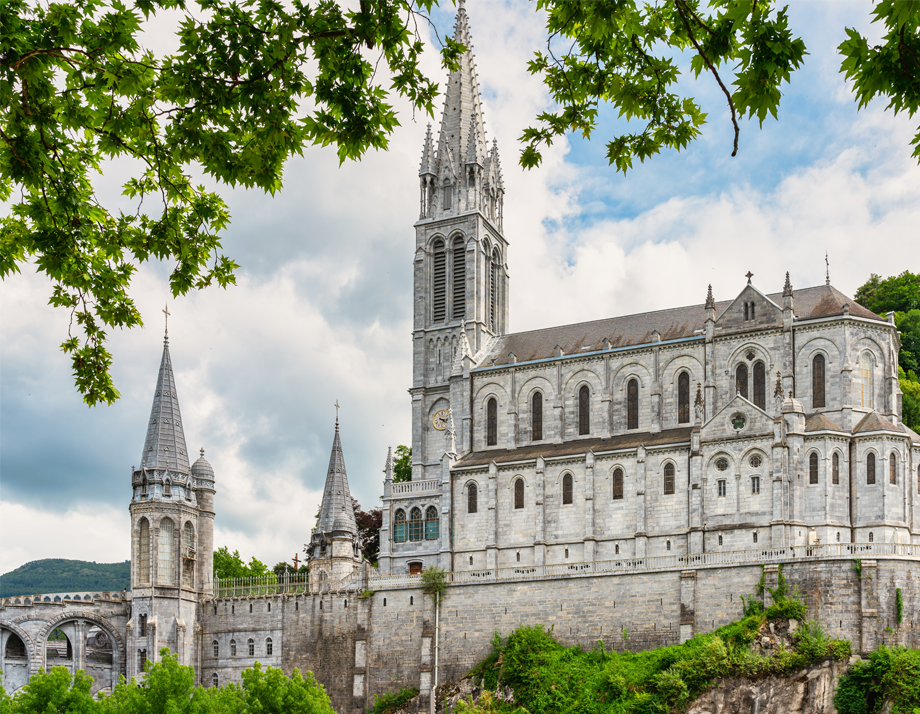2024 Core Leader Pilgrimage to France
Day 1: Thursday, April 4, 2024
PILGRIMAGE MENU
Lourdes – Arrive
Welcome to Lourdes, situated in the foothills of the Pyrenees. Lourdes rose to prominence due to the Marian apparitions and has become one of the most important sites of pilgrimage. Enjoy the day exploring The Sanctuary of Our Lady of Lourdes and the Stations of the Cross on your own.
Hotel: Gallia Londres
Breakfast: on your own
Lunch: on your own
Dinner: on your own

Detailed Agenda
During your renewal time in Lourdes, you may want to view and experience some of the most visited sites.
The Grotto
One of the most visited sites in Lourdes, France is the grotto where the Virgin Mary appeared to the peasant girl Bernadette Soubirous (1844-1879), who was later canonized as St. Bernadette in 1933. In the hollow of the rock where her statue is now seen, the Blessed Virgin appeared to Bernadette eighteen times: During the apparitions, the Blessed Virgin said to the child, “Will you do me the favor of coming here daily for a fortnight? I do not promise to make you happy in this world, but in the next; I want many people to come.” “Go and tell the priests to cause a chapel to be built; I want people to come thither in procession. Go and drink from the fountain and wash yourself in it. Go and eat the grass which is there.” This is a sacred place, a place of prayer and reverence. Consider praying for those who need hope and healing.
Miraculous Spring – La Source, Lourdes
On February 25 Our Lady of Lourdes instructed Bernadette to go to the spring, drink from it, and wash in it. Some have claimed that they have been healed by drinking water from the spring. Studies have found that the water has no special properties at all; it is just normal spring water. It is not considered holy water, which needs to be blessed by a priest. Even St. Bernadette herself said that the Lourdes water had no healing properties, that the healing would come because of faith. You will observe Pilgrims from around the globe filling containers and taking the water home.
The Rosary Basilica
Designed in a Byzantine-influenced Romanesque style in the shape of a Greek (equal-armed) cross, the Rosary Basilica features two unique elliptical ramps embracing a square that can hold almost 80,000 people. Above the main doors of basilica, two mosaic circular panels made in the workshops of the Vatican depict Pope Leo XIII (left) and Bishop Schoepfer of Tarbes and Lourdes (1899-1927). When she appeared at Lourdes, St. Bernadette described the Virgin Mary as holding a rosary in her hand. The Basilica of the Rosary is dedicated to this theme. Its three arches depict the joyful, sorrowful and glorious mysteries. Catholics meditate on these mysteries (events in the lives of Jesus and Mary) while saying the rosary. Around the central dome, the transepts and the sanctuary contain 15 Chapels of the Mysteries, which are decorated with mosaics depicting the 15 mysteries of the rosary (the five joyous, five sorrowful, and five glorious).
The Basilica of St. Pius X (the Underground Basilica)
The Basilica of St. Pius X, known as the Underground Basilica, is the largest and one of the most controversial of churches. It was completed in 1958 in anticipation of the enormous crowds expected in Lourdes for the centenary of the Apparitions. It is a modern, concrete building which is almost entirely underground (part of the building lies beneath the Boulevard Père Rémi Sempé above). The ceiling is low, at only 10 meters (33 ft.) high, and is supported by 58 pre-stressed concrete pillars. These pillars meet 29 concrete beams which cross the ceiling, giving it the impression of an upturned ship. This design creates a very large open space, of 12,000 square meters (130,000 sq. ft.), for maximum visibility from any part of the nave. When full it can accommodate up to 25,000 worshippers. The walls are decorated with the Stations of the Cross, a depiction of the Rosary, and a depiction of the Apparitions, making a total of 52 images, all in the gem mail style of overlapping stained glass.
The Way of the Cross
There are three means of doing the way (stations) of the cross in Lourdes, but by far the most popular is what is known as the “High Stations.” These are fifteen of the most wonderful, larger than life size, tableaus located on the hill overlooking the Sanctuaries. You can pray the stations privately, or join in a group led by a priest, which commences at 9:00 a.m. each morning from the gate facing the front of the basilica. Be warned that the way is more than a mile in length and in places very steep. For those with mobility problems, you are advised to pray the “Low Stations” which are situated over the River Garve on the other side of the sanctuary from the “High Stations.” In bad weather there is a third option in the underground basilica where the stations are made of stained glass and begin in the general area of the organ.
The Holy Stairs
To reach the grotto itself, you have to climb 252 steps (a real workout). Many people choose to light a candle under the shrine and pray for one’s intentions and wishes. The locals have stated that if you make a wish to the Virgin Mary in the Lourdes Grotto, that wish will come true. If you forget to bring a candle, there are vendors at the bottom of the stairs selling them. They also accept candle lighting and prayer requests if you cannot go up the steps.
The Sacred Baths
On Thursday, February 25 1858, the Virgin Mary asked Bernadette to “Go drink in the spring and wash yourself there.” Each year, 350,000 pilgrims do so in the baths of the Sanctuary. The baths are composed of 17 bathtubs made of marble and filled with water of Lourdes. The Hospitaliers (volunteers) help the pilgrims to wash there. The baths are free. Check the times the baths are open and there may be long lines especially in the afternoons.
The Boly Mill – The birthplace of Bernadette
Bernadette was born there on January 7, 1844, and lived there until 1854. Her parents, Louise and Francois, were the tenants of this mill. Bernadette spent a happy childhood in this “mill of happiness.” The failure of François Soubirous’ business obliged the family to leave this comfortable house in June 1854. Today the Boly Mill belongs to the Sanctuary, and it is looked after by the Daughters of the Church.
The Cachot
A prison cell until 1824, this room which is the most squalid of the whole house was given free of charge to the Soubirous family. They stayed there from winter 1857 to the autumn of 1858. It was from there that Bernadette went to the Grotto to meet the Virgin Mary on eighteen occasions. At the time of Bernadette, “The room was dark and unhealthy. The furniture consisted of two rough beds to the right of the entrance and a single small trunk for the linen.” Today, after the renovations during the winter of 95-96, one can see in all its bleakness this room of 3.72 meters by 4.40 meters which served at the same time as a kitchen, dining room, bedroom and a place of prayer for six people. It is the property of the Sanctuary and visited by large crowds of pilgrims during the season. The Sisters of Charity of Nevers look after the building.
The Old Presbytery
At present, this is a public building, the Municipal Library. This is where Bernadette met the Parish Priest, Fr. Peyramale, to relay to the Church authorities the message of the Blessed Virgin. We can still see the door that Bernadette used on her visits to Fr. Peyramale.
Hospice of St. Bernadette
At the time of the apparitions, this was the Hospital-Hospice of “St. Roc” administered by the Sisters of Charity of Nevers. The Sisters also opened a school for the daughters of the poor. Bernadette was accepted there as a pupil between 1858 and 1866. It was in this Hospital-Hospice of “St. Roc” that Bernadette made her First Communion on June 3, 1858. The present General Hospital is built on the site of the former Hospice.
The Church of the Sacred Heart
Built between 1875 and 1903, it retains many reminders of the old Parish Church of St. Peter that was destroyed. On the right-hand side of the transept, is the Baptismal Font where Bernadette was baptized on January 9, 1844, as well as the statues of the Blessed Virgin and St. John the Baptist.
Area Map
